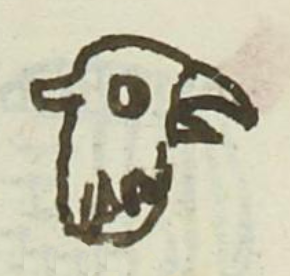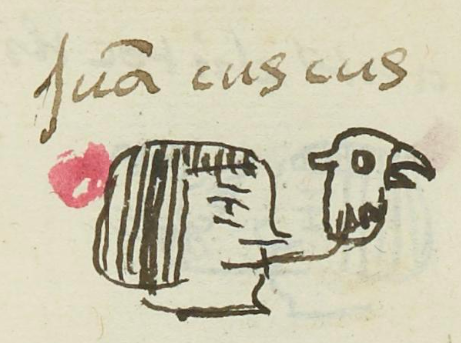Coxcox (MH572r)
This black-line drawing of the simplex glyph for the personal name Coxcox (“Pheasant,” attested here as a man’s name) shows a profile view of the head of a bird [probably the coxcoxtli), a pheasant and/or a nocturnal bird]. Its visible eye and beak are open. It has a feather protruding off the back of its head. The feathers at its neck are spiky.
Stephanie Wood
This is a fairly rare bird, as is the cuixtli (see below). Eagles, egrets, turkeys, hummingbirds, etc., are much more common.
Coxcox was a tlatoani of Culhuacan (Colhuacan), as seen in the Codex Boturini. [See: Lori Boornazian Diel, The Tira de Tepechpan (2009), 30.] He is also mentioned as the son of Acolmiztli in the Codex Xolotl. [See: Eduardo de J. Douglas, In the Palace of Nezahualcoyotl (2012), 228.]
Stephanie Wood
juā cuscus
Juan Coxcox
Stephanie Wood
1560
Jeff Haskett-Wood
pheasants, faisanes, nocturnal bird, pájaros nocturnos, feathers, plumas, nombres de hombres, ave, aves, pájaro, pluma, animals, animales

coxcox, a nocturnal bird, https://nahuatl.wired-humanities.org/content/coxcox
coxcox(tli), a type of pheasant, https://nahuatl.wired-humanities.org/content/coxcoxtli-0
El Faisán Nocturno
Stephanie Wood
Matrícula de Huexotzinco, folio 572r, https://www.loc.gov/resource/gdcwdl.wdl_15282/?sp=223&st=image
This manuscript is hosted by the Library of Congress and the World Digital Library; used here with the Creative Commons, “Attribution-NonCommercial-ShareAlike 3.0 License” (CC-BY-NC-SAq 3.0).





